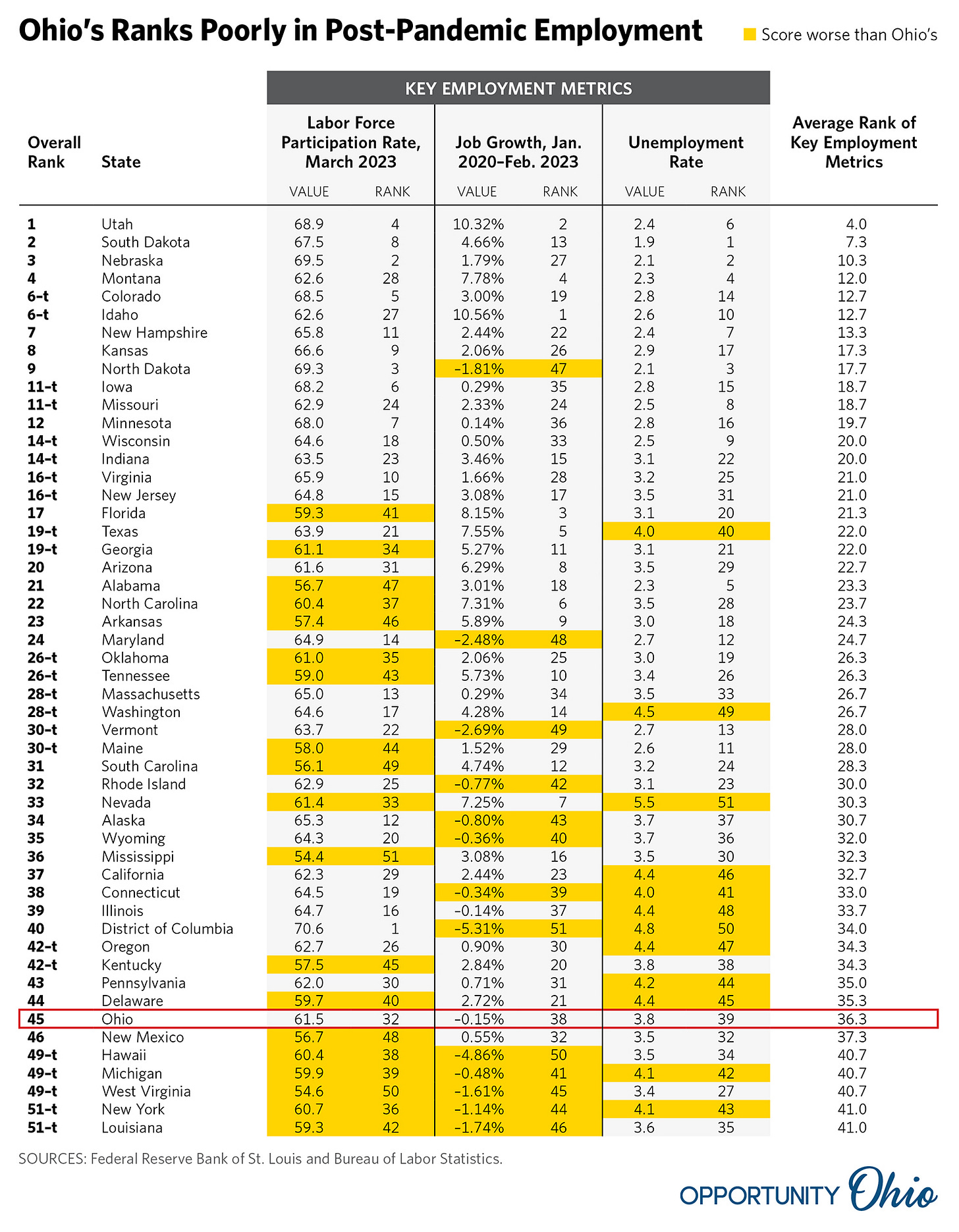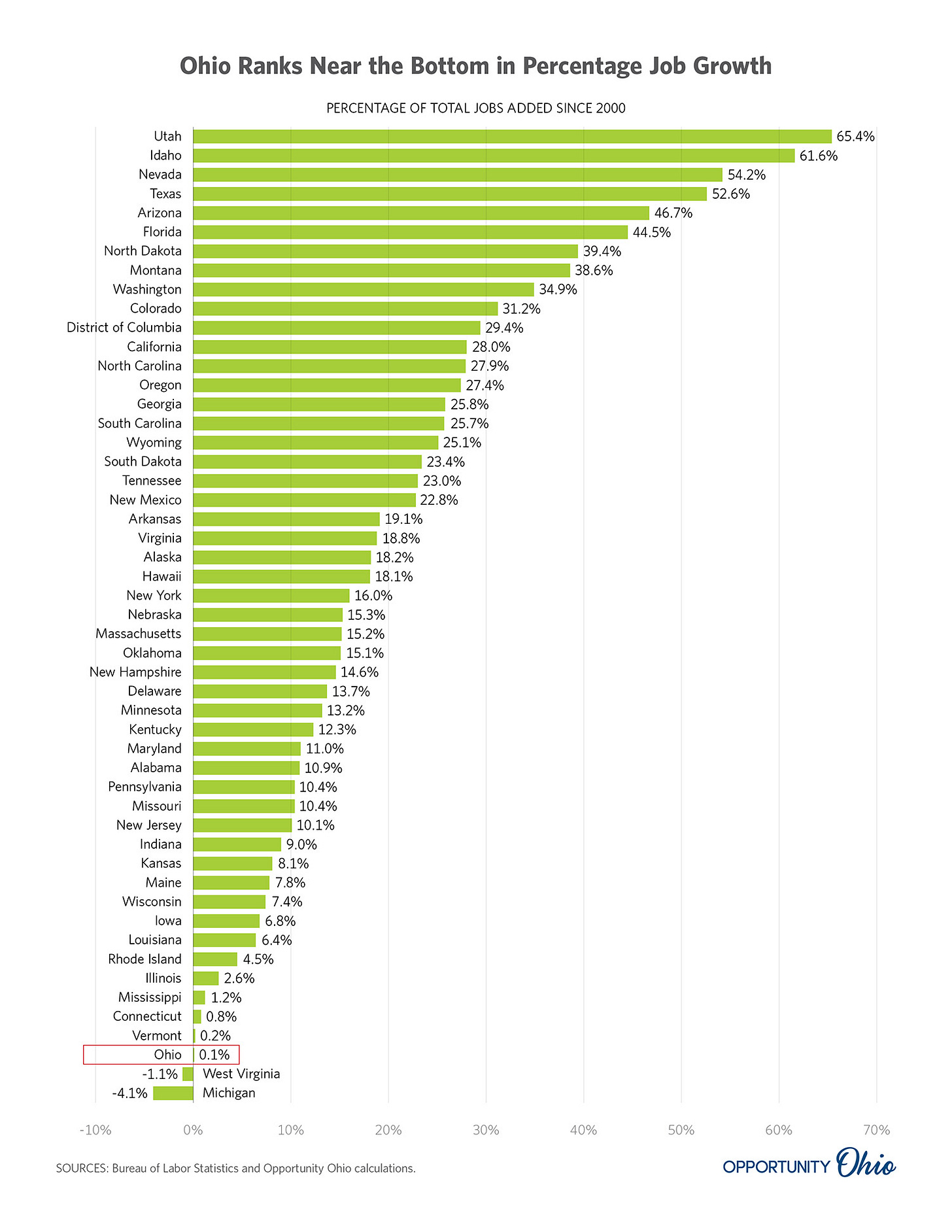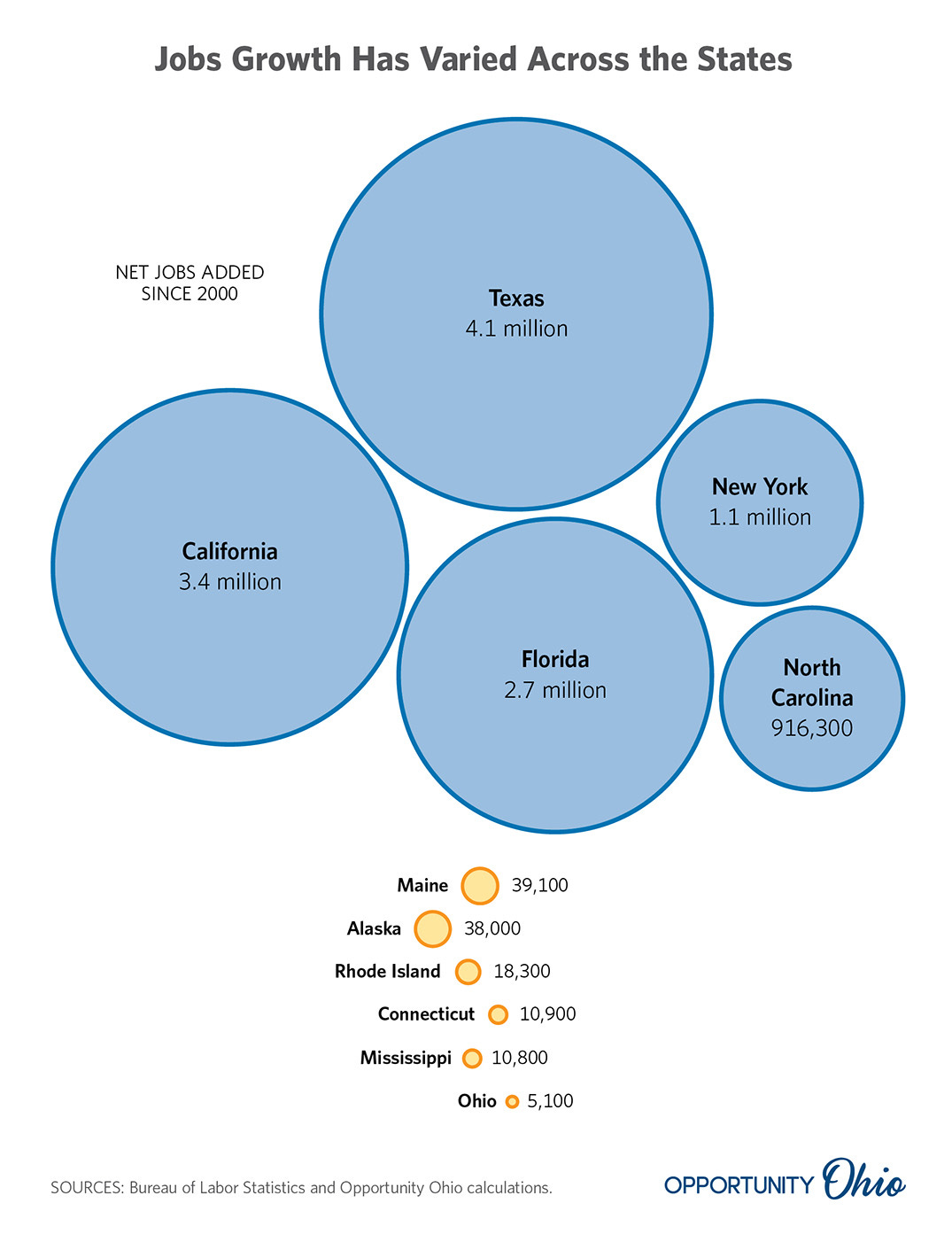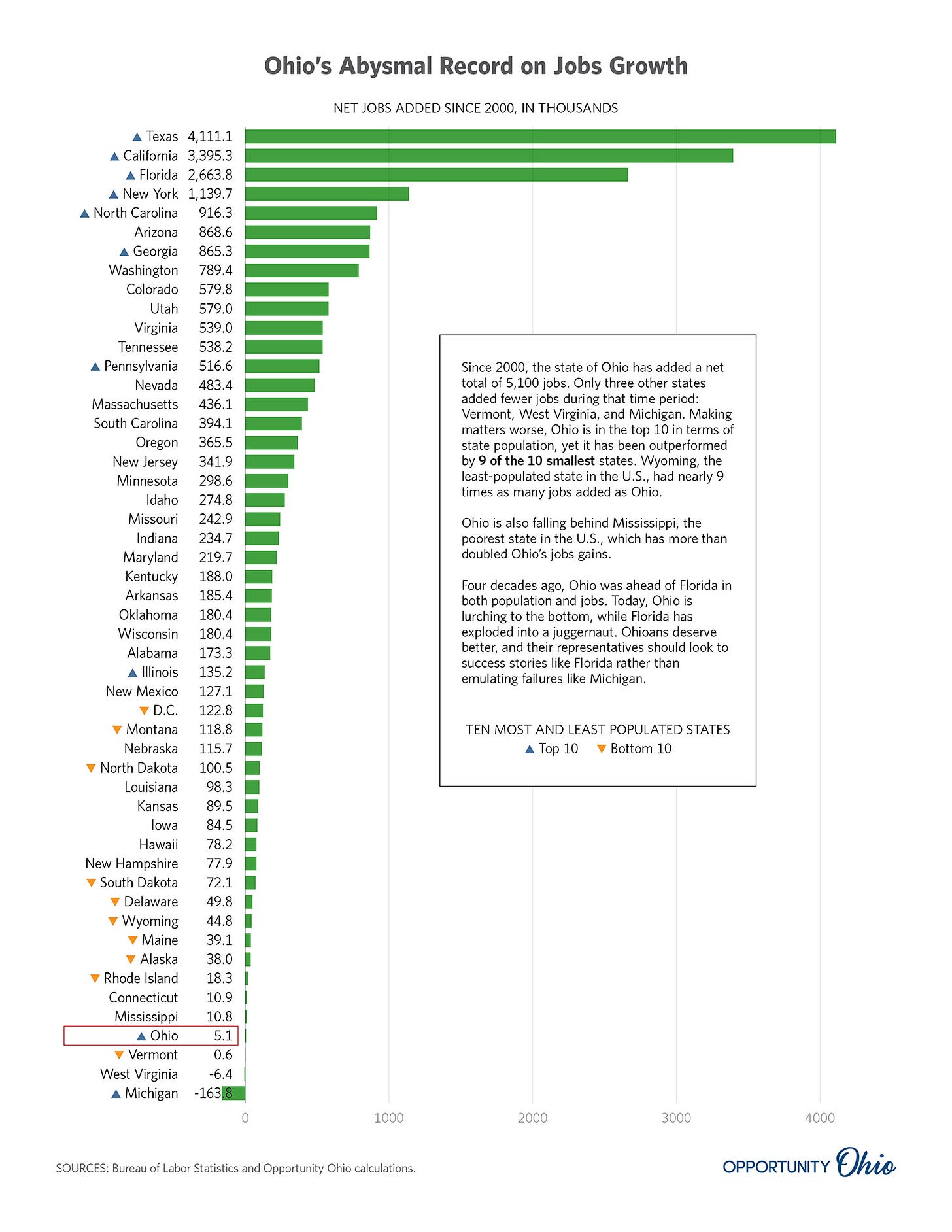Why Is It So Hard for Politicians to Shoot Straight With Ohioans About Our Systemically Underperforming Jobs Economy?
It is like running a personal best, but still coming in last place. No one should get a medal for coming in or near last.
As Mark Twain famously said, there are “lies, damn lies, and statistics!” I understand elected officials want to take credit for good news (“I did that!!”) and ignore or deflect bad news (“Joe Biden did that!”), but the constant dishonesty about the state of Ohio’s jobs economy can be grating. When comparing how Ohio is doing to the other forty-nine states that all face the same headwinds from Washington, D.C., the results are simply ugly. Let me give you two recent examples.
EXAMPLE #1: The DeWine-Husted Administration and its allies love to cite the fact that Ohio’s unemployment rate is “a record low.” That is true, but (yes, there is always a but), when compared to the other forty-nine states, Ohio’s unemployment rate is in the bottom 25% (39th to be precise). So, Ohio compared to its own twenty-three year underperformance is killing it. In the “laboratory of competition” created in our federalist system, however, it is lagging behind most of the states. As I’ve said before, it is like running a personal best, but still coming in last place. No one should get a medal for coming in or near last.
As I’ve mentioned previously, between those opting to stay out of the labor market because they are getting their health care for free via Medicaid expansion under Obamacare and the net loss of nearly 700,000 Ohioans ages 10 to 54 who have fled to other states over the twenty-three years, Ohio’s “record low” unemployment rate is skewed due to a lower labor force participation rate (LFPR). To be clear, it isn’t a good thing a group of Ohioans representing one-seventh of Ohio’s entire private sector have left Ohio for what they deem to be greener pastures. Ohio’s LFPR dropped from 67.4% in 2000 down to 62.1% last month, as the number of available workers (i.e., our labor force) in Ohio only went up by roughly 18,570 workers in 23.3 years despite our population increasing by nearly 400,000 people. So, one must ask: where are all the workers among the 400,000 net new Ohioans (18,570 added workers out of 390,000 net new Ohioans = just 4.8%)?
EXAMPLE #2: With the release of the July preliminary data from the U.S. Bureau of Labor Statistics (BLS), the DeWine-Husted folks were at it again. They yelled from the mountain top that Ohio’s employment had hit a record high (4.857.7 million jobs—I screen out government jobs because those are funded via our taxes) all due to their amazing leadership. Again, that is true (the record, not their leadership), but (there it is again) the complete picture tells a different, far less impressive story.
First, the July BLS figures are preliminary, not final, numbers. As someone who has literally looked at this data every month for the last fifteen or so years, it is often dangerous to base job claims on preliminary data. BLS will make the July data final next month, but even then final doesn’t actually mean final. A report on Tuesday noted experts think 500,000 jobs will disappear from the BLS data when BLS does its next revision. You see, every February, BLS shuts down for a month to scrub the data from the previous years. Every March, BLS releases what most would consider to be the final figures. In past years, I’ve seen Ohio’s annual private sector job total drop from over 100,000 net jobs to far fewer. Think about it, we are an enormous country with over a hundred and fifty million jobs, so subtracting monthly job losses and adding monthly job gains, including part-time workers, can be tricky. Thus, the constant revisions.
Don’t expect to see a press release from the DeWine-Husted folks acknowledging they were premature in their claim if BLS’s revisions push Ohio’s new record back below the previous March 2000 record high.
Next, the record Ohio’s private sector just broke had stood for 23.3 years, which, frankly, isn’t the type of record worth having. No, that isn’t a typo. Waaaaaaaaay back in March of 2000, Ohio’s private sector hit a peak of 4.856 million workers. Facing the same headwinds as every state faces, the failure of Ohio’s elected officials to do the tough stuff to make Ohio the most pro-prosperity, pro-business, pro-worker, and pro-family state in America kept undue burdens on its private sector. The severe DeWine-Husted pandemic shutdown also obviously didn’t help, as it devastated our businesses, schools, and the mental health of so many Ohioans. I’ve previously noted that Ohio was the 39th state to finally get back all of the jobs lost from the DeWine-Husted pandemic shutdown. As a result of so many bad policy decisions and the DeWine-Husted pandemic shutdown, it sadly took Ohio until last month to finally preliminarily surpass the March of 2000 peak.
As a comparison, after adjusting for population differences among the states (i.e., big states might add more net jobs than small states, but, as a percentage, those additions might be smaller), Ohio is ranked 49th at 0.11% net percentage job growth since March of 2000 and was the 49th state to get back to the March of 2000 peak. Only Michigan and West Virginia have done worse than Ohio since 2000. At the same time Ohio surpassed the March of 2000 peak by a mere 5,100 jobs, forty-seven other states have seen job growth…in some cases, massive net job growth. Even historically poor, isolated, and sparsely populated states like Mississippi have added twice the number of net jobs as Ohio did in that span of time. Texas nearly added an entire Ohio private sector during those 23.3 years when its private sector grew by 4.111 million jobs.
Even worse, using raw numbers unadjusted for population differences, Ohio came in 48th. Ohio is the seventh most populous state in America, yet in raw number of net jobs added since March of 2000, we got beat by tiny little states like Rhode Island (+18,300 net jobs added), Wyoming (+44,800), Delaware (+49,800), South Dakota (+72,100), and New Hampshire (+77,900). Heck, Florida added 522.3 times more net jobs than we did.
Finally, did Ohio really get back to the March of 2000 peak? It did as a raw number, but, remember, the peak of 4.856 million jobs was hit when Ohio had 390,000 fewer people. As a percentage of Ohio’s population in the private sector, the March of 2000 peak employment figure is really 42.7%, which represents the number of Ohioans actually working. The number hit last month means 41.3% of Ohioans are working. To get back to the 42.7% peak accounting for population growth, Ohio’s private sector still needs to add 159,550 jobs, or hit 5.017 million total jobs. It is like hitting a record for how far you can hit a golf ball in Columbus, then hitting it the same distance in thinner air at 9,000 feet in Colorado. You have to adjust for how much farther a golf ball will go in thinner air, so 300 yards in Columbus should be 330 yards in the mountains of Colorado. Thus, hitting the same distance in Colorado really isn’t matching the record (and why the Colorado Rockies baseball team performs worse on the road than at home).
One final point: as I’ve previously written about, the importance of right-to-work cannot be dismissed. Specifically, sixteen out of the twenty-five states with the highest net percentage private sector job growth are right-to-work states, with New York being the ONLY forced unionization state not from the south or the west in the top twenty-five. Only ten of the bottom twenty-five states with the lowest net percentage private sector job growth are right-to-work states, with West Virginia (enacted right-to-work in 2016), Wisconsin (2015), Kentucky (2017), and Indiana (2012) only becoming right-to-work in the last ten years, so those economies still need time to fully benefit from becoming right-to-work states. Thus, just six of the bottom states are long-term right-to-work states, with fifteen of the weakest states being forced unionization states.
If Ohio wants to escape this systemically weak jobs economy and become more like Texas and Florida, we need to take these actions:
Enact right-to-work;
Eliminate the state income tax;
Repeal Medicaid expansion under Obamacare;
Truly dig into state government to get rid of regulations that carry a cost greater than any benefits derived;
Build a world-class airport to make it easier for Ohioans and their business to travel and to make Ohio more attractive to non-Ohio businesses;
Leverage Ohio’s natural energy resources to insure businesses and consumers have access to low-cost, plentiful energy;
Rebalance our investments in higher education versus tech/trade so that more of Ohio’s high school graduates get the training they need for the 21st century; and
Fight aggressively to keep Ohio jobs for Ohioans and those in America legally.
With Republican governors and a supermajority Republican legislature, these policies should have already been enacted, but our current elected officials don’t support doing any of these tough actions, which is why they mislead Ohioans with press releases that are grossly at odds with how Ohio’s jobs economy is really doing compared to our competitors in the other forty-nine states. No one other than me will do the items listed above (or will die trying), so if you like Ohio being at the bottom of the list year-after-year and watching our best and brightest leave for greener pastures, don’t vote for me. If, however, you want fundamental bold color change as President Ronald Reagan implored us to do, then I’m your man.
ICYMI, here is my weekly interview on The Bruce Hooley Show where we discussed the Republican Presidential Debate, Donald Trump’s interview with Tucker Carlson, and my letter to every member of the Republican State Central Committee to stop forty-four people from taking away the ability of voters to determine who their winners will be.











Ahem...."Gains for June and July were revised down by a total of 110,000 jobs to a respective 105,000 and 157,000, the government said." https://www.foxbusiness.com/economy/us-jobs-report-august-2023
Matt - It was a pleasure to meet you at the MCFAN meeting this morning.
You mentioned China’s involvement in the pandemic. The US government is involved even more so.
https://nationalarm.org/
Something else you might want to read:
https://merylnass.substack.com/p/how-the-usg-pulled-off-the-coup-to?utm_source=substack&utm_medium=email